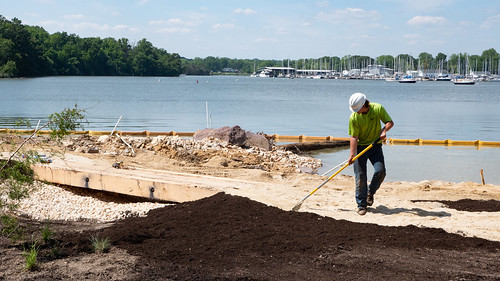
Crews constructing a living shoreline for flood mitigation in 2021, photo by Stephen Badger, Maryland Department of Natural Resources.
The Maryland Department of Natural Resources announced more than $2.9 million in competitive grants for 12 climate resilience projects to help communities design and construct solutions to withstand flooding and other weather-related events.
The selected projects will reduce risk for vulnerable communities, incorporate climate change data into existing plans and policies, and develop nature-based or natural solutions to help control flooding.
Funding is provided by the state’s Resiliency Through Restoration Initiative, the U.S. Environmental Protection Agency, and the National Oceanic and Atmospheric Administration.
Grant funding for Fiscal Year 2025 is awarded to the following local governments and community partners, pending final approval by federal partners:
Baltimore City:
- Baltimore City Office of Sustainability – To create Watershed Master Plans for two of the five 8-digit watersheds within city boundaries to align with the City mission to holistically address flooding. The watersheds selected are Gwynns Falls and Baltimore Harbor.
- Church of the Guardian Angel – To construct green infrastructure practices, create a green alley, and complement Baltimore City stormwater infrastructure improvements that will improve water quality and help reduce stormwater flooding in the neighborhood of Remington.
Baltimore County:
- Christian Liberty Church – To design green infrastructure practices with rain garden, permeable paver, and landscaping features that improve water quality and help reduce stormwater flooding on West Baltimore and Reisterstown church properties.
Calvert County:
- Neeld Estate Citizens Association and Arundel Rivers Federation – To construct a living shoreline along the Neeld Estate community that reduces erosion and increases community resilience.
- Town of North Beach – To design green infrastructure practices with step pool, permeable pavement, and landscaping features that reduce stormwater flooding and improve water quality.
Charles County:
- Charles County Resiliency Authority – To design a living shoreline for Popes Creek Waterfront to address flooding, erosion, and loss of marsh habitat.
Dorchester County:
- City of Cambridge – To design green infrastructure practices with bioswale and swale features for a new city stormwater park to reduce flooding and improve water quality.
- Nanticoke Watershed Alliance – To design green infrastructure practices with swale, berm, step pool and rain garden features that reduce stormwater flooding at a historically Black church on the Underground Railroad and Harriet Tubman Byway.
Kent County:
- National Wildlife Federation – To design a living shoreline at Minary’s Dream Alliance that addresses erosion and provides community access to Morgan Creek, a tributary of the Chester River.
Queen Anne’s County:
- Queen Anne’s County – To construct a thin-layer sediment placement project to enhance the elevation of the tidal marsh with locally sourced dredged material. This project will demonstrate the cost-effective use of dredged material to enhance community and ecological resilience to sea level rise at the Chesapeake Bay Environmental Center.
Talbot County:
- Town of St. Michaels – To design and build a living shoreline that replaces a failing bulkhead at a public park and helps mitigate coastal flooding impacts.
- Town of St. Michaels – To conduct a feasibility study to assess the flood mitigation benefits of a tide gate at the St. Michaels Nature Trail Bridge.
Beginning in July, the Department of Natural Resources will accept applications for the next fiscal year through the department’s online Grants Gateway.
